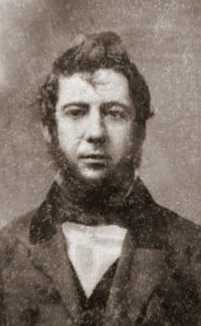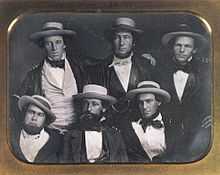Alexander Cartwright
| Alexander Joy Cartwright | |
|---|---|
 Cartwright in 1855 | |
| Born |
Alexander Joy Cartwright, Jr. April 17, 1820 New York City, US |
| Died |
July 12, 1892 (aged 72) Honolulu, O'ahu, Kingdom of Hawai'i |
| Known for | Invention of the modern game of baseball |
| Signature |
|
Alexander Joy Cartwright, Jr. (April 17, 1820 – July 12, 1892) is one of several people sometimes referred to as a "father of baseball". Cartwright is thought to be the first person to draw a diagram of a diamond-shaped baseball field, and the rules of the modern game are based on the Knickerbocker Rules developed by Cartwright and a committee from his club, the Knickerbocker Base Ball Club.[1] With the myth of Abner Doubleday inventing baseball debunked, Cartwright was inducted into the National Baseball Hall of Fame as an executive 46 years after his death.[2][3] Cartwright was officially declared the inventor of the modern game of baseball by the 83rd United States Congress on June 3, 1953.[2][4][5][6]
Early life and work
Cartwright was born in 1820 to Alexander Carwright, Sr., a merchant sea captain, and Esther Burlock Cartwright. Alexander Jr. had six siblings. He first worked at the age of 16 in 1836 as a clerk for a Wall Street broker, later doing clerical work at Union Bank of New York. After hours, he played bat-and-ball games in the streets of Manhattan with volunteer firefighters. Cartwright himself was a volunteer, first with Oceana Hose Company No. 36, and then Knickerbocker Engine Company No. 12.[7][1]
Cartwright married Eliza Van Wie, from Albany, on June 2, 1842.[7]
A fire destroyed Union Bank in 1845, forcing Cartwright to find other work. He became a bookseller with his brother, Alfred.[7]
Knickerbocker Base Ball Club

Cartwright led the establishment of the Knickerbocker Base Ball Club (after the Knickerbocker Fire Engine Company) in 1842. The Knickerbockers played a brand of bat-and-ball game called town ball on a field at 4th Avenue and 27th Streets.[1]
In 1845 Cartwright and a committee from his club drew up rules converting this playground game into a more elaborate and interesting sport to be played by adults. The original 14 rules were somewhat similar to but not identical to the English sport of rounders. Three exceptions devised by Cartwright included the stipulations that the playing field had to be laid out in a diamond-shape rather than a square used in rounders, foul territories were to be introduced for the first time, and the practice of retiring a runner by hitting him with a thrown ball was forbidden.[9] Cartwright is also credited for introducing flat bases at uniform distances, three strikes per batter, and nine players in the outfield.[10]
The first clearly documented match between two baseball clubs under these rules took place on June 19, 1846, at Elysian Fields in Hoboken, New Jersey. In this match, the Knickerbockers lost to the "New York Nine" by a score of 23 to 1.[11] Some authors have also questioned the supposed "first game" under the new rules. The Knickerbockers' score-book shows games during 1845 also. Those who have studied the score-book have concluded that the differences in the games of 1845 and 1846, compared with the specifications of the Knickerbocker rules, are minimal, such as fielding teams of seven players instead of nine.
Hawaii
In 1849, Cartwright headed to California for the gold rush, but ended up in the Hawaiian Islands instead. His family came to join him in 1851: wife Eliza Van Wie, son DeWitt (1843–1870), daughter Mary (1845–1869), and daughter Catherine (Kate) Lee (1849–1851). In Hawaii sons Bruce Cartwright (1853–1919) and Alexander Joy Cartwright III (1855–1921) were born. He set up a baseball field on the island of Oahu at Makiki Field.
Cartwright served as fire chief of Honolulu from 1850 through June 30, 1863.[12] As advisor to King David Kalākaua and Queen Emma he encouraged the growth of baseball on the islands until his death on July 12, 1892, a year before the overthrow of the Hawaiian monarchy in 1893. One of the leaders of the overthrow movement was Lorrin A. Thurston who played baseball with classmate Alexander Cartwright III at Punahou School. He was buried in Oahu Cemetery.[11]
Legacy
.jpg)

After about two decades of controversy, invention of America's "national game" of baseball was attributed to Abner Doubleday by the Mills Commission (1905–1907). Some baseball historians promptly cried foul and others joined throughout the 20th century. Cartwright was inducted into the Baseball Hall of Fame in 1938.
New York City librarian Robert W. Henderson documented Cartwright's contributions to baseball in his 1947 book Bat, Ball, and Bishop, which Congress cited in recognizing Cartwright as the inventor of the modern game.[13] Although there is no question that Cartwright was a prominent figure in the early development of baseball, some students of baseball history have suggested that Henderson and others embellished Cartwright's role. The primary complaint is that touting Cartwright as the "true" inventor of the modern game was an effort to find an alternative single individual to counter the "invention" of baseball by Abner Doubleday.
Cartwright was the subject of a 1973 biography, The Man Who Invented Baseball, by Harold Peterson.[14] He was the subject of two biographies written in 2009. Jay Martin's Live All You Can: Alexander Joy Cartwright & the Invention of Modern Baseball supports Cartwright as the inventor of baseball, while Alexander Cartwright: The Life Behind the Baseball Legend by Monica Nucciarone credits Cartwright as one of the game's pioneers but not its sole founder.[15]
The Cartwright Cup is awarded to the Hawaii state high school baseball champions each year.[16] Makiki Field has been renamed Cartwright Field.[17]
See also
References
- ↑ 1.0 1.1 1.2 Lloyd, J & Mitchinson, J: The Book of General Ignorance. Faber & Faber, 2006.
- ↑ 2.0 2.1 Ty Cobb: Safe at Home. Globe Pequot. 2008. ISBN 9780762744800.
- ↑ "Alexander Cartwright". Alexander Cartwright.
- ↑ Alice Low and John O'Brien (2009). The Fastest Game on Two Feet: And Other Poems About How Sports Began. Holiday House. ISBN 9780823419050.
- ↑ "Year In Review : 1953 National League". Baseball Almanac.
- ↑ Jim Lilliefors (2009-07-01). Ball Cap Nation: A Journey Through the World of America's National Hat. Clerisy Press. ISBN 9781578604111.
- ↑ 7.0 7.1 7.2 Monica Nucciarone. "Alexander Cartwright". Society for American Baseball Research. Retrieved 8 January 2014.
- ↑ The identification of Cartwright in this image is at least controversial. Articles seriously challenging this identification can be found in Society of American Baseball Research (SABR) newsletters at "Just Another Misidentified Baseball Photo?". Society of American Baseball Research. October 2011. Retrieved August 16, 2012. and at " So, are there any Knickerbockers in that 1840’s half-plate daguerreotype?". Society of American Baseball Research. March 2012. Retrieved August 16, 2012.
- ↑ "Alexander Cartwright: First Modern Game of Baseball 1845". Baseball Historian.
- ↑ Baseball: A History of America's Favorite Game. Random House Digital, Inc. 2008-12-24. p. 21. ISBN 9780307494061.
- ↑ 11.0 11.1 Nucciarone, Monica (2009). "Chapter 2: The Knickerbocker Base Ball Club of New York". Alexander Cartwright: The Life Behind the Baseball Legend. Lincoln, Nebraska: University of Nebraska Press. pp. 12–22. ISBN 978-0-8032-3353-9.
- ↑ "Cartwright, A. J. office record". state archives digital collections. state of Hawaii. Retrieved 2010-01-06.
- ↑ Robert William Henderson (1947). Ball, bat and bishop: the origin of ball games. Rockport Press.
- ↑ Thorn, John (March 12, 2011). "Debate Over Baseball's Origins Spills Into Another Century". The New York Times. Retrieved August 28, 2013.
- ↑ Bailey, James. "Dueling Cartwright biographies offer differing views of his contributions". Baseball America. Retrieved August 28, 2013.
- ↑ "Cartwright Cup for state baseball champ unveiled today". The Honolulu Advertiser. May 6, 2007. Retrieved August 28, 2013.
- ↑ "The Father of Baseball". The Hawaiian Historical Society. Retrieved August 28, 2013.
External links
| Wikimedia Commons has media related to Alexander Cartwright. |
- Alexander Cartwright at the Baseball Hall of Fame
- BaseballLibrary – biography
- Open-Site – biography
- "Alexander J. Cartwright Jr. Bio". Mr Baseball.com.
- "Alexander Cartwright". Find a Grave. Retrieved September 3, 2010.
- Alexander Cartwright at the SABR Bio Project, by Monica Nucciarone, retrieved October 16, 2013
- Doc Adams at the SABR Baseball Biography Project, by John Thorn, retrieved October 16, 2013
- "Four Fathers of Baseball" by John Thorn. Thorn Pricks July 16, 2005.
| ||||||||||
| ||||||
|